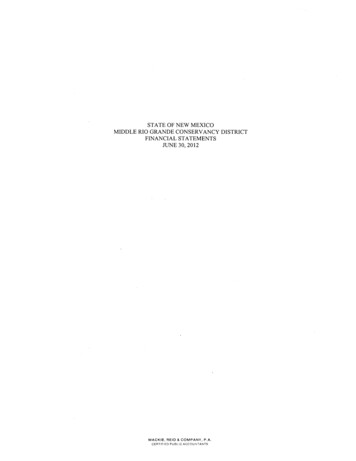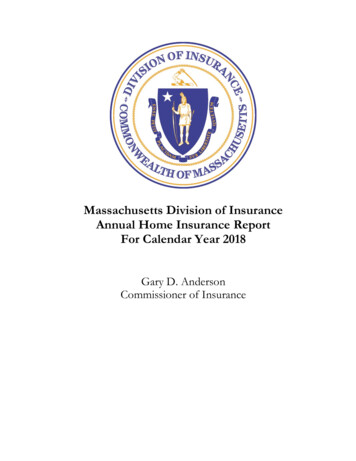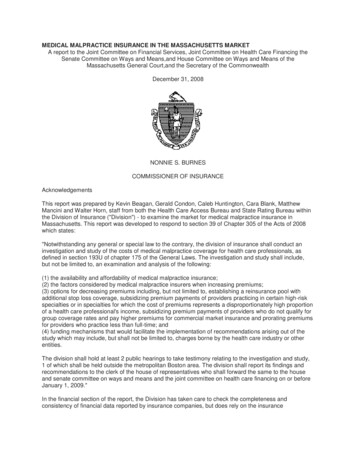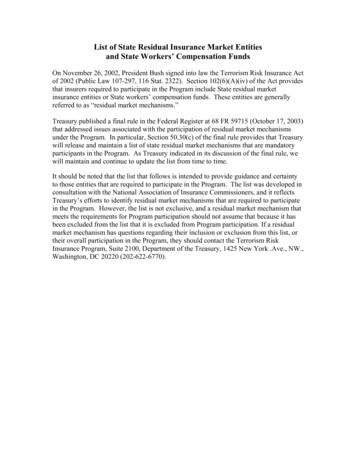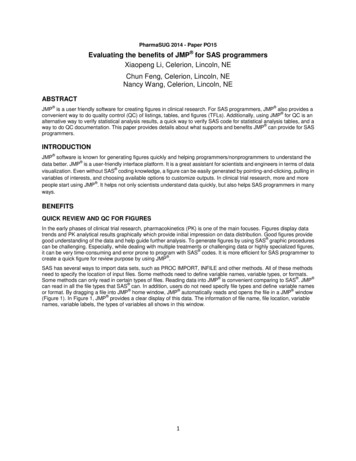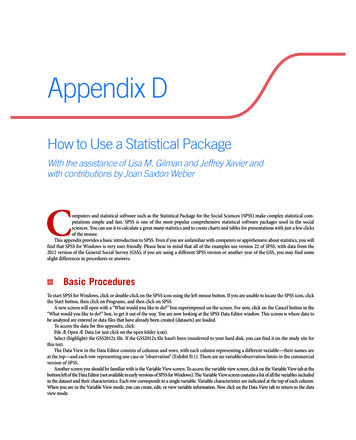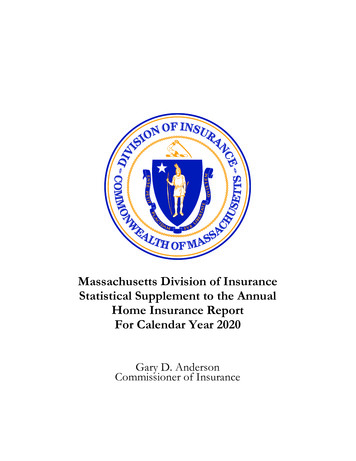
Transcription
Massachusetts Division of InsuranceStatistical Supplement to the AnnualHome Insurance ReportFor Calendar Year 2020Gary D. AndersonCommissioner of Insurance
IntroductionThe enclosed statistical supplement was prepared by the State Rating Bureau staff of the Massachusetts Division ofInsurance (“Division”). Matthew M. Mancini, State Rating Bureau Director, Gerald B. Condon, State Rating BureauResearcher, Caleb E. Huntington, State Rating Bureau Mathematician, Bashiru Abubakare, State Rating BureauActuary / Statistician as material that complement what is included in the 2020 Annual Report on the MassachusettsMarket for Home Insurance.The material included in this statistical supplement to the annual report is based primarily on responses fromcompanies and statistical reporting organizations reflecting the experience of companies in the home insurancemarket. Unless otherwise noted in the report, references to home insurance, includes traditional home insurance,as well as condominium and rental insurance. The Division makes all appropriate efforts to check thecompleteness and consistency of data reported by insurance companies and their statistical agents, but doesrely on the insurance companies for the accuracy of all reported information.
STATISTISICAL SUPPLEMENT TOTHE 2020 REPORT ONTHE MASSACHUSETTS MARKET FOR HOME INSURANCEPage Title17102020 Market SummaryHistory of Multi-Peril Home Insurance in MassachusettsExhibit 1A M.G.L. c. 175, § 4AExhibit 1B M.G.L. c. 175, § 4B1112FAIR Plan Credits and Credit Eligible Zip CodesExhibit 2A 2020 FAIR Plan Calendar Year Credit Eligible Zip Codes and WeightsExhibit 2B 2020 FAIR Plan Calendar Year Coastal Zip Codes Eligible for Take-Out Credits1314Wind DeductiblesExhibit 3A Mandatory Wind/Hurricane/Named Storm Deductible SummaryExhibit 3B Policies In-Force for Selected Zip Codes - Wind/Hurricane/Named Storm Deductibles1920352020 Premiums and Losses (M.G.L. c. 175, § 4A)Home Insurance Written PremiumExhibit 4A 2018-20 Total Market Home Written Premium by TerritoryExhibit 4B 2018-20 Total Market Home Written Premium by Zip CodeExhibit 4C 2018-20 FAIR Plan Home Premium Market Share by Territory36404448Home Insurance Premium & Loss Experience by TerritoryExhibit 5A 2020 Voluntary Market Home Premium & Loss Experience by Territory by FormExhibit 5B 2020 FAIR Plan Home Premium & Loss Experience by Territory by FormExhibit 5C 2020 Total Market Home Premium & Loss Experience by Territory by FormExhibit 5D 2020 Top 25 Insurers/FAIR Plan Aggregate Premium & Loss Experience by Zip Code757677Home Insurance Loss RatiosExhibit 6A Changes in Massachusetts Loss Ratios, All Home FormsExhibit 6B Changes in Massachusetts Loss Ratios, Home Forms OnlyExhibit 6C 2020 Cause of Loss by Territory by Form, All Home Forms889092222227228229Causes of Home LossesExhibit 7A 2016-20 Percent of Loss Dollars by Cause of Loss by TerritoryExhibit 7B Snowfall, Boston, Massachusetts, 1979-2021 Winter SeasonsSnowfall, Boston, Massachusetts, 2007-2020 Calendar Years2020 Home Insurance Cancellation/Nonrenewal (M.G.L. c. 175, § 4B)Exhibit 8A Individual Insurer and FAIR Plan 2020 Cancellation/Nonrenewal ReportsExhibit 8B Top 25 Insurers and FAIR Plan 2020 Aggregate Cancellation/Nonrenewal ReportExhibit 8C Summary of 2020 CancellationsExhibit 8D Summary of 2020 NonrenewalsExhibit 8E 2020 Renewal/Nonrenewal Claims History
HISTORY OF MULTI-PERIL HOMEINSURANCE IN MASSACHUSETTS1
[Page intentionally left blank]2
Multi-Peril Home InsuranceThe Division of Insurance produces “Understanding Home Insurance” 1 that describes the differing typesof home insurance. Home insurance has several forms, but ordinarily the insured is the occupant. In thisreport, statistics on home insurance refer to traditional home insurance, as well as condominium and rentalinsurance.Fire insurance on real property has been commonplace in the United States since the nineteenth century.In the 1950’s, multi-peril home insurance policy was introduced. This coverage provided a morecomprehensive coverage for damage from additional perils, as well as fire and protection against personalliability arising from use of the real property. Multi-peril home insurance policies became the standard bythe 1960’s with Insurance Services Office, Inc. (ISO), an industry rating and statistical organization, as thelead sponsor of the standard home insurance policies since that time. 2 The Division of Insurance maintainsa listing on its website 3 of 90 commercial insurance companies that have indicated they have written tenor more home insurance policies in the second half of 2020 in Massachusetts.Creation and Evolution of the Massachusetts FAIR PlanIn the 1960’s, there were periods of civil unrest resulting in extensive property damage (not to mentionloss of life) in a number of large metropolitan areas across the United States. Many insurers withdrew fromoffering property coverage in urban areas. A national advisory panel on the nation’s cities advised thePresident of the United States that fair access to property insurance was a prerequisite for revitalization ofurban America and called for a significant change in the insurance and reinsurance markets in relation tothe protection of urban property. Following the recommendation of the advisory panel, the Commonwealthof Massachusetts created the Urban Area Insurance Placement Facility (Facility) shortly before Congressenacted the Urban Property and Reinsurance Act of 1968 authorizing the establishment of state “FAIR(Fair Access to Insurance Requirements) Plans” along with federal riot reinsurance to insurers.The Facility served as Massachusetts’ FAIR Plan, both issuing residual market coverage on behalf of itsmembers insurers and performing some of the functions of a traditional insurance company that inspectsproperty, collects premium, and adjusts claims. The coverage initially offered through the FAIR Planincluded a standard fire insurance policy for both personal and commercial lines, which also covered directloss from the perils of vandalism and malicious mischief. The enabling act contemplated that the Facilitywould operate in “urban areas” designated by the Commissioner. 4 In 1970, the Commissioner of Insurancebroadened the designated area of operations for the Facility to include the entire Commonwealth ofMassachusetts. The Commissioner also established that the commission rate to producers placing businessin the FAIR Plan would be 12% of the premium charged to the insured. 5In 1975, the Commissioner of Insurance expanded the personal lines coverage offered by the FAIR Planfrom what is covered in a standard fire insurance policy to what is covered in a multi-peril insurance policy.In addition, the Commissioner required that premium rates charged by the FAIR Plan to home be tied tothe published manual rates of the ISO (Insurance Services Offices) rating organization for standard homerisks. 6“Understanding Home Insurance” is available at Understanding Home Insurance Mass.gov.General revisions of these home policies – usually referred to as HO-3 plans - have historically been filed by ISO on anintermittent basis, usually once every five to ten years.3The listing of home insurance companies on the Division of Insurance website can be located at Companies Issuing 10 orMore Home Insurance Policies in Second Half of 2020 - By County Mass.gov.4Chapter 731 of the Acts of 1968 defined “urban area” as “any city or town, or streets or sections thereof, in thecommonwealth so designated by the commissioner after appropriate hearing.” This designation was subsequentlyaccomplished through regulation 211 CMR 5.00.5The 12% commission rate has remained constant since that time6The ISO rates were based on premium and loss data from all insurance companies that reported their premium and loss data toISO as their statistical agent. These insurers at that time collectively wrote more than 70% of the home insurance market inMassachusetts.123
Studies of Urban Insurance Availability (Redlining)During the 1990s, there appeared to be continued problems in the availability of home insurance in urbanareas and some analysts claimed that insurance companies had been “redlining” or unfairly discriminatingagainst certain risks solely due to the geographic location and/or the racial or ethnic characteristics ofpotential insureds. “Redlining” is and has been a controversial issue in property insurance since at least the1960’s and charges of redlining have been raised against certain property insurers and the propertyinsurance industry as a whole over the years.In 1993-95, the National Association of Insurance Commissioners (NAIC) undertook several studies onthe issues of availability and affordability of urban insurance in the personal automobile and homeinsurance markets; 7 the studies were not conclusive regarding redlining in urban areas. These studies dididentify problems in obtaining coverage in many urban areas, but they were not able to pinpoint whetherthis could be solely tied to company underwriting practices, or whether it was also due to the lack of urbaninsurance producers (agents or brokers), rate inadequacy for certain urban areas, or carrier misconceptionsrelative to urban risks. It was generally found, however, that premiums were higher in urban areas. 8In 1995, following the release of the NAIC studies, the Massachusetts Division of Insurance (DOI) SpecialInvestigative Unit (SIU) conducted an examination of eight insurers who were major writers of coveragein the Massachusetts home insurance market and representative of the home market as a whole. 9 The SIUexamination focused on the marketing and underwriting practices of these insurers in the Boston area. Thepurpose of the examination was to determine whether any of the eight insurers were engaged in unlawfuldiscrimination in underwriting in Boston or any of its neighborhoods. This examination did not reveal anyillegal discrimination by these insurers.The NAIC studies helped focus attention on the need for insurers to reassess their approach to urbanmarkets. In Massachusetts, this resulted in at least two small changes. First, a brokerage system wasdesigned to help insurers find potential customers who met their underwriting criteria. 10 Second, theMassachusetts Affordable Housing Alliance (MAHA) and several insurers undertook to encourage riskmanagement training for insureds in urban areas, with discounted premiums made available as a rewardfor completion of the training.Chapter 93 of the Acts of 1996Following the publication of the NAIC studies and the subsequent DOI examination of urban homepolicies, a number of parties with a role in the home market - including insurers, insurance producers,consumers, legislators, and regulators - wanted to address the availability of home insurance in urban andcoastal areas in the voluntary market. 11 They considered whether there should be monetary incentives forinsurers to write urban and coastal property in the voluntary market, changes in the way that Facilityoperated and residual market rates were determined, and regular reporting so that the DOI couldanalyze home insurance data on both a company and industry basis.Chapter 93 of the Acts of 1996 restructured the Facility and made several changes in the FAIR Planoperation, Chapter 93 made the following changes:1. Eliminated the portions of the enabling act providing for an insurance placement facility and replaced themwith language establishing a form of joint underwriting association, the Massachusetts Property InsuranceA Preliminary Analysis of Urban Insurance Markets, Robert W. Klein, 1994. Urban Insurance Problems And Solutions:Interim Report, National Association of Insurance Commissioners Insurance Availability and Affordability (EX3) Task Force,1994. The Impact of Loss Costs on Urban Home Insurance Markets, Robert W. Klein, 1995.8The loss costs (cost of claims) associated with homes and businesses in those areas were higher as well.9Report of Examination of Homeowner Insurance Availability in The Metropolitan Boston Area, Massachusetts Division ofInsurance, November 1995.10This Market Assistance Plan (MAP) was required by Chapter 93 of the Acts of 1996.11The voluntary market is a group of insurers who write insurance in an environment that allows the right to acceptand reject business submitted. The voluntary market does not include Excess or Surplus Lines.74
Underwriting Association (MPIUA), which, like the Facility, would issue policies on behalf of its memberinsurers and serve as the Massachusetts FAIR Plan. 122. Provided FAIR Plan assessment credits in 1997-98 for insurers writing voluntary business in territories wherethe FAIR Plan had high market penetration.3. Required FAIR Plan to provide assessment credits starting January 1, 1999 for insurers writing voluntarybusiness in zip codes where the FAIR Plan had high market penetration. (See Exhibit 2A)4. Provided FAIR Plan assessment credits (“take-out credits”) for insurers writing voluntary business in coastalterritories where more than 60% of the territory business had previously been written in the FAIR Plan.5. Required FAIR Plan to provide take-out credits starting January 1, 1999 for insurers writing voluntary businessin coastal zip codes where the FAIR Plan had a greater than 60% market penetration. (See Exhibit 2B)6. Tied FAIR Plan to rate changes in the voluntary market 13. (See Exhibit 2C)7. Provided for the top twenty-five insurers and the FAIR Plan to annually provide detailed cancellation andnonrenewal information by zip code for home insurance.8. Provided that statistical agents for home insurance in Massachusetts are to submit premium and loss datareports by zip code and type of coverage, including detail on the causes of loss for each reported company. 149. Provided that the Commissioner of Insurance report annually on the state of the Massachusetts home insurancemarket after substantial analysis of the data submitted in (6) and (7).10.Authorized alternative loss settlement practices subject to the use of disclosure forms designed by theCommissioner.11.Required the FAIR Plan to offer coverage through an installment plan and provide coverage for scheduledpersonal property.12.Required the FAIR Plan to develop a market assistance plan (MAP) to assist applicants to obtain homeinsurance in the voluntary market.Changes to FAIR Plan/MPIUA Rating RulesChapter 175C, section 5 requires the FAIR Plan to develop its rates by territory and follow differentrating rules for homes in “large share territories” - where the FAIR Plan has a significant share of thebusiness – as compared to all other homes.Previously, in large share territories, the FAIR Plan rates could not increase by more than the “overallstatewide average percentage increase” of the top 10 largest home insurance by market share in theMassachusetts in the prior calendar year. For all other territories, the commissioner could disapprove theFAIR Plan’s proposed rates if they exceed the ninetieth percentile of the rates in use in the territory by the10 insurers with the largest market shares of home insurance written in the commonwealth on a statewidebasis.In 2004 two major changes were made to the ways that FAIR Plan rates are calculated: The law was changed to modify “large share territories.”o Defined large share territories as ones covering 7% of more of the home premium over thepast 3 years.o Limited the number of “large share territories” to 13 in any one year The Commissioner of Insurance was directed to consider the effects of predicted hurricane lossesand the cost of catastrophe reinsurance when examining the FAIR Plan’s proposed rates.Due to continuity of mission, membership, and operations, the terms MPIUA and FAIR Plan are often usedinterchangeably.13Chapter 436 of the Acts of 2004 (An Act Relative to the Joint Underwriting Association) permits the FAIR Plan to factor inthe predicted costs of hurricane losses and the cost of catastrophe reinsurance.14The first data submission provided in 1996 was exclusively on a territorial basis. All subsequent data submissionshave been required to include certain data on a zip code basis.125
6
Exhibit 1AGENERAL LAWS OF MASSACHUSETTSPART I. ADMINISTRATION OF THE GOVERNMENTTITLE XXII. CORPORATIONSCHAPTER 175. INSURANCEPOWERS AND DUTIES OF COMMISSIONER OF INSURANCEChapter 175: Section 4A. Provision of data to commissioner by homeownersinsurers and joint underwriting association; access to confidential data; annualreport to general courtSection 4A. As of July first, nineteen hundred and ninety-six, and annually thereafter,each admitted insurer writing homeowners insurance in the commonwealth, inaccordance with the provisions of section four, and the joint underwriting association,formed pursuant to the provisions of chapter one hundred and seventy-five C shallfurnish for examination and inspection by the commissioner of insurance, in accordancewith section five of chapter one hundred and seventy-five C, for the owners, tenants andcondominium, separately, forms of homeowners insurance written since January first,nineteen hundred and ninety-four, by standard statistical territories approved by thecommissioner, a statistical report of its homeowners insurance experience showing thefollowing data: written premiums; earned premiums; incurred losses, including lossadjustment expenses; loss ratio; number of incurred claims; and number of exposures.As of July first, nineteen hundred and ninety-seven, or such later reasonable date as thecommissioner may order after a hearing, but not later than July first, nineteen hundredand ninety-eight, the twenty-five admitted insurers with the largest homeowners marketshare in the commonwealth and the joint underwriting association, formed pursuant to theprovisions of chapter one hundred and seventy-five C, shall furnish such data as providedin the preceding paragraph on the basis of the postal zip codes of credit-eligibleterritories, under the plan authorized by section four of chapter one hundred and seventyfive C, of all other postal zip codes in the city of Boston and such other postal zip codesas may be designated by the commissioner.All data reports shall be formatted and produced in accordance with the NationalAssociation of Insurance Commissioners statistical handbook. Compliance with therequirements of this section shall be effected through statistical agents approved by thecommissioner to act on behalf of the reporting insurers. In setting the effective date fordata reporting in accordance with the preceding paragraph, the commissioner shallconsider the practical ability of each statistical agent to so collect and report such datawith an acceptable level of statistical credibility.7
Exhibit 1AAccess to such confidential data shall be granted by the commissioner to the attorneygeneral, to the extent he so requests, for law enforcement purposes, and to the chairmenof the joint committee on insurance; provided, however, that the attorney general and thechairmen of the joint committee on insurance shall hold and keep such data confidential.All information reported pursuant to this section shall be given confidential treatment andshall not be subject to subpoena and shall not be made public by the commissioner,attorney general, chairmen of the joint committee on insurance, or any other person,without the prior written consent of the insurer to which it pertains, except by the insurer;provided, however, that if the commissioner, after giving the insurer and its affiliates whowould be affected thereby, as well as the person or organization making the request,notice and the opportunity to be heard, determines that the interests of policyholders,shareholders or the public will be served by the publication thereof. In the event that thecommissioner determines that such publication is appropriate, he may publish all or partof such data in such manner as he deems appropriate. Such hearing shall be heldaccording to the adjudicatory procedures in chapter thirty A of the General Laws.As of October first, nineteen hundred and ninety-six, and annually thereafter, thecommissioner shall report to the general court concerning the current state of thehomeowners insurance market in the commonwealth, both voluntary and residual market,and the conclusions reached by the commissioner based upon his most recentexamination and inspection of the industry premium and loss data. Each such annualreport shall be filed with the clerks of the senate and house of representatives who shallforward the same to the joint committee on insurance, the house and senate committeeson ways and means and the attorney general. Such report shall be made available to thepublic by the commissioner. Said report shall summarize on an aggregate industry basis,by standard statistical territory and, when available, by zip code, broken down betweenvoluntary and residual markets, the data concerning premiums and losses on homeownersinsurance disclosed by the reporting insurers. Further, said report shall substantivelyanalyze: the causes of loss and any trends discerned from the data by the commissioner;the respective market shares and levels of rate subsidies of the residual market policieswritten by the joint underwriting association, formed pursuant to the provisions ofchapter one hundred and seventy-five C, compared to the voluntary homeownersinsurance market; the availability and affordability of homeowners insurance in thoseterritories whose association market share equals or exceeds four percent, with particularattention to credit-eligible territories; and the impact of such rate subsidies of the residualmarket policies written by said association upon the availability of homeownersinsurance in the voluntary insurance market.Each such annual report shall further examine the availability of homeowners insurancethrough the admitted insurers and the joint underwriting association, formed pursuant tothe provisions of chapter one hundred and seventy-five C, in coastal municipalities, aswell as the extent to which direct losses to residences caused by wind affect suchavailability. Said report may also contain any recommendations of the commissionerconcerning legislation or other suggestions relative to the homeowners insurance market,loss control or disaster mitigation in the commonwealth.8
Exhibit 1APremium, loss and other data of individual insurers collected and examined by thecommissioner shall not be specifically identified in said report; provided however that thecommissioner shall, in an appendix, profile, separately for the twenty-five admittedinsurers with the largest homeowners market share in the commonwealth based uponstatewide written premium and, for the joint underwriting association, formed pursuant tothe provisions of chapter one hundred and seventy-five C, the gross number of exposures,cancellations and non-renewals that each insured under homeowners insurance formsduring the relevant time period covered by the data examined and inspected by thecommissioner, in each such postal zip code or standard statistical territory for which datawas collected and examined by the commissioner pursuant to this section. Thecommissioner’s report shall also include an appendix which tabulates the industryaggregate number of homeowners policy non-renewals and cancellations effected duringsuch relevant time period as reported to the commissioner pursuant to the provisions ofsection four B of chapter one hundred and seventy-five.9
Exhibit 1BGENERAL LAWS OF MASSACHUSETTSPART I. ADMINISTRATION OF THE GOVERNMENTTITLE XXII. CORPORATIONSCHAPTER 175. INSURANCEPOWERS AND DUTIES OF COMMISSIONER OF INSURANCEChapter 175: Section 4B. Annual report to commissioner of cancellations and nonrenewals of homeowners policiesSection 4B. The commissioner, each year, shall direct and cause the twenty-five admittedinsurers with the largest homeowners market share in the commonwealth, based uponstatewide written premium and the joint underwriting association, formed pursuant to theprovisions of chapter one hundred and seventy-five C, to submit directly for hisinspection and examination a tabulation and report, for each postal zip code within crediteligible territories, as defined by chapter one hundred and seventy-five C, of all otherpostal zip codes in the city of Boston, and such other postal zip codes as may bedesignated by the commissioner of insurance, of the number of effected cancellations andnumber of effected non-renewals of homeowners policies covering properties within suchzip codes; provided, however, that the personal privacy of policyholders shall bepreserved and all tabulations furnished pursuant hereto shall be deemed materialsdescribed in subclause (c) of clause Twenty-sixth of section seven of chapter four.10
Exhibit 2A2020 FAIR PlanCalendar Year CreditEligible Zip Codes and WeightsZip 21220190202345026720266602662City/Town(NEW BEDFORD)(OCEAN BLUFF)(CUTTYHUNK)(DENNISPORT)(WHITE HORSE BEACH)(WEST DENNIS)(HUMAROCK)(ONSET)(BRANT ROCK)(BOSTON)(WEST HARWICH)(OAK BLUFFS)(NORTH EASTHAM)(SOUTH CHATHAM)(BOSTON)(GREEN HARBOR)(WEST YARMOUTH)(BOSTON)(WEST CHATHAM)(SOUTH (MATTAPAN)(HARWICHPORT)(BOSTON)(MONUMENT BEACH)(SOUTH HARWICH)(EASTHAM)(CHELSEA)(NEW BEDFORD)(NEW BEDFORD)(SOUTH YARMOUTH)(BOSTON)(WAREHAM)(HYANNIS)(NORTH TRURO)(WELLFLEET)(BOSTON)(LYNN)(MANOMET)(WEST HYANNISPORT)(TRURO)(SOUTH 1
Exhibit 2B2020 FAIR PlanCalendar Year Coastal Zip CodesEligible for Take Out-CreditsZip CodeCity/TownNo coastal zip codes were eligible for take-out credits.12
Exhibit 3AMandatoryDeductible SummaryCompanyAllstate Insurance GrpAmerican Family Ins GrpAmerican International GroupAmica Mut GrpAndover GrpArbella Ins GrpBarnstable GrpChubb Ltd GrpHeritage Insurance Holdings Group (formerly NBIC Holdings Grp)Liberty Mut GrpMetropolitan GrpMapfre Ins GrpNew London County GrpNorfolk & Dedham GrpPlymouth Rock Ins GrpPreferred Mut Ins CoPure Companies GrpQuincy Mut GrpSafety Grp (The)Travelers GroupThe Hanover Ins GrpUnited Ins Holdings GrpUnited Services Automobile Asn GrpUniversal Ins Holdings GrpVermont Mut GrpFAIR ane Named StormXXXXXXXXXXXXXXXXXXXXXXXXXX13
Mandatory Wind DeductibleReportTop Twenty-Five Insurers & FAIR PlanCalendar 8520185301854019010190201903City/Town/Post IELDSPRINGFIELDINDIAN RWORCESTERWORCESTERCHERRY WELLLOWELLLOWELLLOWELLLOWELLLYNNLYNNLYNNPoliciesin Force*as of ,6916,553224,0012266,57124Policiesin ForceMandatory Wind/HurricaneDeductibleas of 72107924769361,1382684303,03212Exhibit 3BPage 1Percentage of Policies withMandatory 1%13.3%46.1%50.0%14
Mandatory Wind DeductibleReportTop Twenty-Five Insurers & FAIR PlanCalendar 1380213902140021410214202143City/Town/Post OfficeLYNNLYNNLYNNBRANT ROCKGREEN HARBORHULLHUMAROCKMINOTOCEAN OSTONMATTAPANBOSTONBOSTONCHARLESTOWNJAMAICA PLAINROSLINDALEWEST ROXBURYBOSTONALLSTONBRIGHTONHYDE AMBRIDGESOMERVILLEPoliciesin Force*as of iciesin ForceMandatory Wind/HurricaneDeductibleas of 34441676Exhibit 3BPage 2Percentage of Policies withMandatory .8%7.5%12.8%15
Mandatory Wind DeductibleReportTop Twenty-Five Insurers & FAIR PlanCalendar 196021990220102202022
with language establishing a form of joint underwriting association, the Massachusetts Property Insurance . 7. A Preliminary Analysis of Urban Insurance Markets, Robert W. Klein, 1994. Urban Insurance Problems And Solutions: Interim Report, National Association of Insurance Commissioners Insurance Availability and Affordability (EX3) Task Force .
